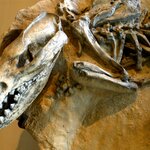Paleontology

In the never-ending battle between cat and dog owners, one factoid can't be denied: cats are terrible at helping take down big game.
But mammoth kill sites in Europe that containing lots of mammoth bones - up to 86 of the beasts - used for dwellings has led Penn State Professor Emerita Pat Shipman to formulate a new hypothesis of how these sites were formed.
Shipman
suggests that their abrupt appearance may have been due to early modern humans working with the earliest domestic dogs to kill the now-extinct mammoth. Shipman even believes there is a way to test the predictions of her…

Where did the earliest Americans come from?
Speculation has pointed to Eastern Asia, Western Asia, Japan, Beringia and even Europe. Differences in cranial form between today's Native Americans and the earliest known Paleoamericans have lent credence to all possibilities but the analysis of a nearly complete Paleoamerican skeleton with Native American DNA that dates close to the time that people first entered the New World may have some answers to part of the puzzle.
The skeleton of the teenage girl, given the name Naia by the scholars, was found in Hoyo Negro ("black hole"), a deeply…
Deep in the water of a Yucatán Peninsula cave, one of the oldest human skeletons found in North America has been discovered.
"Naia" is the the researchers' name for the teenage girl who went underground, presumably to seek water, and fell to her death in a large pit named Hoyo Negro - "black hole" in Spanish.
The girl's skeleton is between 13,000 and 12,000 years old and genetic analysis shows the prehistoric girl and living Native Americans came from the same place during the initial peopling of the Americas. The near-complete human skeleton -- with an intact cranium and preserved DNA…

An ancient kitten-sized predator is one of the smallest species reported in the extinct order Sparassodonta, which were carnivorous marsupials (metatherian mammals, anyway) native to South America lived in Bolivia about 13 million years ago.
The researchers can't name the new species because the specimen lacks well-preserved teeth, which are the only parts preserved in many of its close relatives.
The skull, which would have been a little less than 3 inches long if complete, shows the animal had a very short snout. A socket, or alveolus, in the upper jaw shows it had large, canines, that…

Researchers have discovered a new fossil organism from the Ediacara Biota, a group of organisms that occurred in the Ediacaran period of geologic time.
Named Plexus ricei and resembling a curving tube, the organism resided on the Ediacaran seafloor. Plexus ricei individuals ranged in size from 5 to 80 centimeters long and 5 to 20 millimeters wide.
Along with the rest of the Ediacara Biota, it evolved around 575 million years ago and disappeared from the fossil record around 540 million years ago, just around the time the Cambrian Explosion of evolutionary history was getting under way.…

Scientists have discovered a new species of long-snouted tyrannosaur, nicknamed Pinocchio rex, which stalked the Earth more than 66 million years ago.
The dinosaur, officially named Qianzhousaurus sinensis, was unearthed in southern China and confirms the existence of long-snouted tyrannosaurs. Researchers say the anima was a fearsome carnivore that lived in Asia during the late Cretaceous period.
The newly found ancient predator looked very different from most other tyrannosaurs. It had an elongated skull and long, narrow teeth compared with the deeper, more powerful jaws and…

Synchrotron-imaging techniques have shed new light, literally, on the healing process that took place when dinosaurs were still alive.
They examined the cracks, fractures and breaks in the bones of a 150 million-year-old predatory dinosaur - possible because dinosaur bones occasionally preserve evidence of trauma, sickness and the subsequent signs of healing.
Diagnosis of such fossils used to rely on the grizzly inspection of gnarled bones and healed fractures, often entailing slicing through a fossil to reveal its cloying secrets. But the synchrotron-based imaging, which uses light…

The La Brea Tar Pits in California are known for saber-toothed cats and mastodons but they also have insects. Recent examination of fossil leafcutter bee nest cells, led by Anna Holden of Natural History Museum of Los Angeles County and colleagues, reveal insights into the habitat and climate at the La Brea Tar Pits toward the last Ice Age.
Holden conducted the study with bee specialists Jon B. Koch and Dr. Terry Griswold from Utah State University, paleobotanist Dr. Diane M. Erwin, from the University of California Berkeley, and Justin Hall from NHM, who used micro CT scans to…

Somewhere around 180 million years ago, during the Jurassic period, the southern Swedish county of Skåne was a tropical paradise populated by dinosaurs and volcanoes.
One sudden volcanic eruption caused a fern to be preserved instantaneously and now researchers from Lund University and the Swedish Museum of Natural History have made a unique discovery; both undestroyed cell nuclei and individual chromosomes have been found in the plant fossil.
The well-preserved fossil has been studied using different microscopic techniques, X-rays and geochemical analysis. The examinations reveal…

Genetic analysis of ancient poop found off the coast of Mexico suggests bighorn sheep may be native to Tiburón Island, the largest island in the Gulf of California and Mexico.
Bighorn sheep were not thought to inhabit Tiburón Island prior to their introduction in 1975 but scientists discovered fossilized dung in the mountains of Tiburón Island that challenges that assumption. Scientists compared the pellet-shaped poop to fecal pellets of other large mammals and extracted DNA to sequence and determine the origin.
Carbon dating suggests the poop originated from 1470-1630 years ago. Genetic…